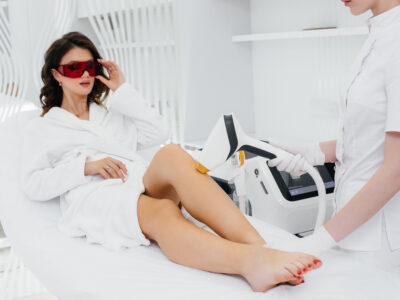Do you want to get rid of unwanted hair on your face or body? Save time, money and discomfort by taking an appropriate decision. Try laser hair removal and remove unwanted hair forever.

To understand precisely how laser hair removal works, we need to understand how hair grows. Hair growth takes place from within the hair follicle in a three-phase cycle. The length of the cycle depends on the type of hair, its thickness, colour and the area on the body. Also the rate of growth varies from person to person. For example, the active growth phase of the hair on your head may extend over many years, while the active growth phase of the hair on your body may extend over a few months.
Laer Hair Removal – Key Factors
We present below details about the procedure for selection of patients, preoperative preparation, laser safety and the impact of laser devices and post-operative care.
The ability to remove unwanted hair using lasers, whether temporarily or permanently, has brought about a revolutionary change in the lives of many people. Several factors are responsible for success of laser treatment. They include aspects such as patient selection, preparation prior to surgery, informed consent, understanding the principles of laser safety and the selection of laser and light source.
Understanding hair anatomy, physiology, growth and laser-tissue interaction, particularly in choosing optimal laser parameters, is absolutely necessary prior to using lasers for removal of hair.
Patient selection
In selecting a patient, there is a need for a focused medical history, physical examination and informed consent, such as setting realistic expectations and potential risks.
Patients who have endocrine or menstrual dysfunction must be checked as also those who have an explosive onset of hypertrichosis. It is better to avoid non-urgent conditions in pregnant women although there is no evidence of potential risks.
It is important to review previous medical history of the patient to identify photosensitive conditions which include autoimmune connective tissue disorders, or disorders prone to Koebner phenomenon.
It is also necessary to check for recurrent cutaneous infections at or near treatment area that may warrant the use of prophylactic medications. Past history of keloid or hypertrophic scar formation is also required.
It is important to review all previous hair removal methods, including LHR. For example, hair shaft epilation such as waxing or tweezing that remove the target chromophore, make LHR less effective for a minimum of 2 weeks. Usually it is advisable to wait for a minimum of 6 weeks after complete epilation of the hair shaft and laser treatment. However, depilatory and shaving creams can be used up to the day of laser treatment as they do not remove the entire shaft.
Medical history is critical as intake of gold is a contraindication for laser therapy. With the use of Q-switched lasers, there is the risk of the complication of chyrsiasis.
Patients on isotretinoin may be given a washout period prior to laser treatment. Topical retinoids may be stopped for 1 or 2 days prior to the treatment. Additionally, one may need to assess the patient’s reaction to unprotected sun exposure.
A physical examination will help decide which lasers and light sources are safe for a particular patient because epidermal melanin in darkly pigmented patients competes with the melanin in the hair follicles as a chromophore.
It is important to evaluate every patient for the presence of a tan. Laser treatment must be delayed, if there is a tan, or the treatment parameters must be adjusted appropriately until the tan fades. One must also note the patient’s hair colour as the chromophore for LHR is melanin. Typically, black and brown terminal hairs contain sufficient melanin to serve as chromophore for LHR.
On the other hand, the lack of melanin or presence of eumelanin in the hair follicle, which correlates with white, gray or red and blonde hair respectively, is indicative of a poor response to laser hair removal.
Factors such as coarseness and density of hair are also important to note as they tend to influence parameter settings.
Informed consent
Informed consent necessitates a review of the possible risks of LHR that include temporary and permanent hypo or hyperpigmentation, blister formation, scar formation, ulceration, folliculitis, hive-like response, bruising, infection and acne flare.
The low risk of paradoxical hypertrichosis, while treating the lateral jaw and face, must be reviewed for those who have Fitzpatrick skin type IV or are of Asian or South Asian, Middle Eastern or Mediterranean descent.
Patients need to be counseled that complete and permanent hair removal is unlikely, but with multiple treatments, significant long-term reduction can be achieved. Hirsute women with hormonal abnormalities may require continued maintenance therapy and must be advised of the possibility.
LHR is expected to cause procedural pain but this can be minimized with topical anesthetics. Edema and erythema may last for a week. In addition, one needs to strictly avoid the sun for a minimum of 6 weeks before and after each treatment.
Contact Us
If you are considering Laser Hair Removal contact our team of experts who will be happy to guide you. We offer you a painless Laser Hair Removal session with ALMA SHR. You will also find that Laser Hair Removal in Scarborough is more affordable than GTA. Find out more and book your consultation at [email protected] or call us at 647-660-0860
